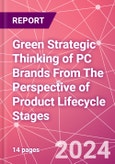This product will be delivered within 3-5 business days.
Table of Contents
1. Most PC Brands Committed to Achieving Net Zero by 20501.1 Brands Develop Net Zero Value Chains While Setting Circular Economy Goals for Products
1.2 Applying Sustainable Concepts to Create Green PCs
2. The Circular Economy of PC Products Starts with Production Processes
2.1 Design and Procurement - Inclusive of Innovative Sustainable Material Applications in the Design Stage
2.1.1 Design and Procurement Process Strategies
2.1.2 Specific Actions in the Design and Procurement Process
2.2 Production and Manufacturing - Improving Energy Efficiency and Using Renewable Energy to Support Low-Carbon Energy
2.2.1 Manufacturing and Production Strategies
2.2.2 Specific Actions in Production and Manufacturing
2.3 Packaging and Logistics - Reducing Packaging Waste and Improving Transportation Efficiency
2.3.1 Packaging and Logistics Strategies
2.3.2 Specific Actions in Packaging and Logistics
2.4 Recycling and Remanufacturing - Expanding Product Recycling Mechanisms for Added Value after Recycling
2.4.1 Recycling and Remanufacturing Strategies
2.4.2 Specific Actions in Recycling and Remanufacturing
3. The Analyst's Perspective
Appendix
List of Companies
List of Tables
Table 1: Leading PC Brands' Recycling Programs and Service Descriptions
List of Figures
Figure 1: Leading International Brands' Net-Zero Carbon Emissions and Circular Economy Goals
Figure 2: Major PC Brands' Sustainable Notebook PC Products
Figure 3: PC Brands' Production Process Strategies
Companies Mentioned (Partial List)
A selection of companies mentioned in this report includes, but is not limited to:
- Acer
- Apple
- ASUS
- Butler-MacDonald
- Chakr Innovation
- Compal
- Daisy
- Dell
- Goodwill
- Homeboy Industries
- HP
- Lavergne
- Lenovo
- Lonely Whale
- PDR
- Quanta
- SABIC
- Sims Lifecycle Services
- Sony
- Taz
- Wistron
Methodology
Primary research with a holistic, cross-domain approach
The exhaustive primary research methods are central to the value that the analyst delivers. A combination of questionnaires and on-site visits to the major manufacturers provides a first view of the latest data and trends. Information is subsequently validated by interviews with the manufacturers' suppliers and customers, covering a holistic industry value chain. This process is backed up by a cross-domain team-based approach, creating an interlaced network across numerous interrelated components and system-level devices to ensure statistical integrity and provide in-depth insight.
Complementing primary research is a running database and secondary research of industry and market information. Dedicated research into the macro-environmental trends shaping the ICT industry also allows the analyst to forecast future development trends and generate foresight perspectives. With more than 20 years of experience and endeavors in research, the methods and methodologies include:
Method
- Component supplier interviews
- System supplier interviews
- User interviews
- Channel interviews
- IPO interviews
- Focus groups
- Consumer surveys
- Production databases
- Financial data
- Custom databases
Methodology
- Technology forecasting and assessment
- Product assessment and selection
- Product life cycles
- Added value analysis
- Market trends
- Scenario analysis
- Competitor analysis

LOADING...








